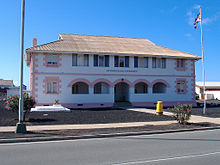Constitution of St. Helena, Ascension and Tristan da Cunha

The constitution of St. Helena, Ascension and Tristan da Cunha , English The Constitution of St Helena, Ascension and Tristan da Cunha, is the supreme law of the British overseas territory of St. Helena, Ascension and Tristan da Cunha . It was introduced on September 1, 2009, having previously been approved by the United Kingdom's Privy Council .
The greatest peculiarity of the constitution of 2009 is the raising of the status of Ascension and Tristan da Cunha to areas equivalent to St. Helena . The Constitution is continuously from one partnership ( English Partnership ) spoken between the sub-regions and the mainland as well as within the sub-regions.
construction
The preamble to the constitution recognizes the respective historical features of the sub-areas, including the status as a bishopric and the city status of Jamestown on St. Helena.
The constitution is divided into three chapters, one for each sub-area of the overseas territory. Each chapter guarantees human rights . St. Helena is run by a governor who represents the mother country. The legislature comes from the Legislative Council . Ascension and Tristan da Cunha are each of a posted administrator (Administrator) out and Island Councils (Councils Iceland) managed.
Individual evidence
- ^ The St Helena, Ascension and Tristan da Cunha Constitution Order 2009. Legislation.gov.uk, 2009, no. 1751.
- ^ Change of name and establishment of Constitution. The Constitution of St Helena, Ascension and Tristan da Cunha Order, paragraph 4, p. 2
- ^ The St Helena, Ascension and Tristan da Cunha Constitution Order 2009, Preamble. Legislation.gov.uk, 2009, No. 1751.
